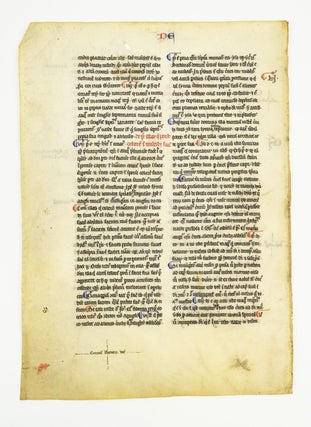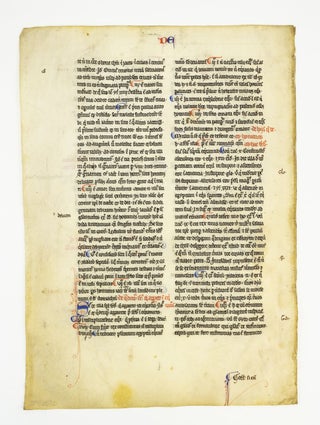TEXT FROM "DE SUPERBIA"
(France: second half of the 13th century). Each leaf measures 330 x 240 mm. (13 x 9 3/8"). Double column, 38 lines of text in a proto-gothic hand.
Rubrics in red, running title and numerous paragraph marks in red and blue, one leaf with one two-line initial in blue with red pen flourishes. Margins with several text corrections, one leaf with a catch-word. ◆Faint soiling and a few negligible stains touching text (not affecting legibility), but overall FINE SPECIMENS with very few flaws.
Containing part of a popular treatise on the Vices, these well-preserved and attractive large format leaves come from a manuscript that may have been contemporary to the life of the author, William Perault (ca. 1190-1270). Although the so-called "Seven Deadly Sins" that we still recognize today remained a popular moral paradigm throughout the Middle Ages, it was by no means canonical. Authors were free to borrow, manipulate, and elaborate on the topic at will, resulting in a profusion of treatises and competing systems of morality. This work by Perault (Latin: Peraldus) was a particularly prominent treatise that not only survived the Middle Ages, but later went into print in several editions. The "Summa of Vice" expounds upon the Seven with which most of us are familiar--Pride, Envy, Anger, Sloth, Greed, Gluttony, and Lust--but it also includes an eighth sin, which Perault called "peccatum linguae," or "the sin of the tongue." The present leaves consider the sin of Pride (Superbia), the most severe and dangerous of all the vices (in Medieval imagery it is often depicted as the root of all other sins), with some interesting discussion of garish dress, make-up, hair coloring, and wigs. (ST13657a)
Price: $3,250.00

.jpg?width=768&height=1000&fit=bounds&auto=webp&v=1601396941)

.jpg?width=320&height=427&fit=bounds&auto=webp&v=1601396941)
